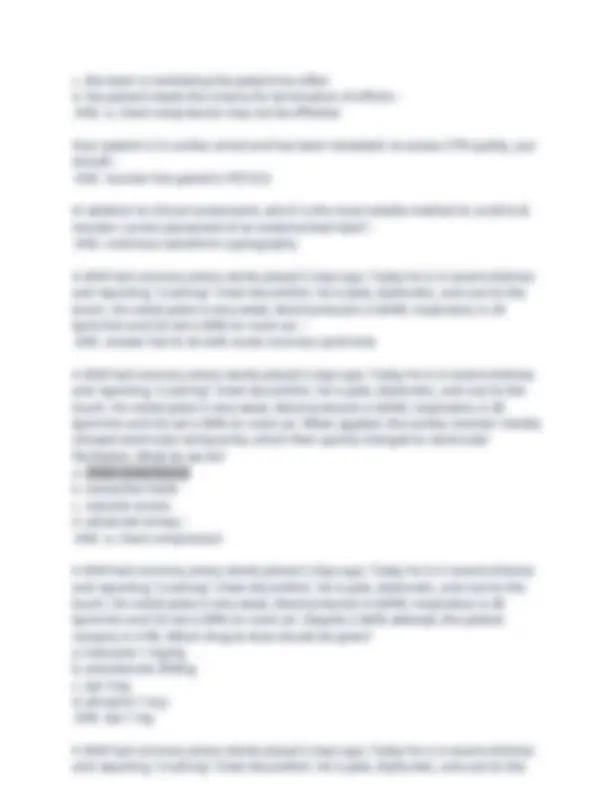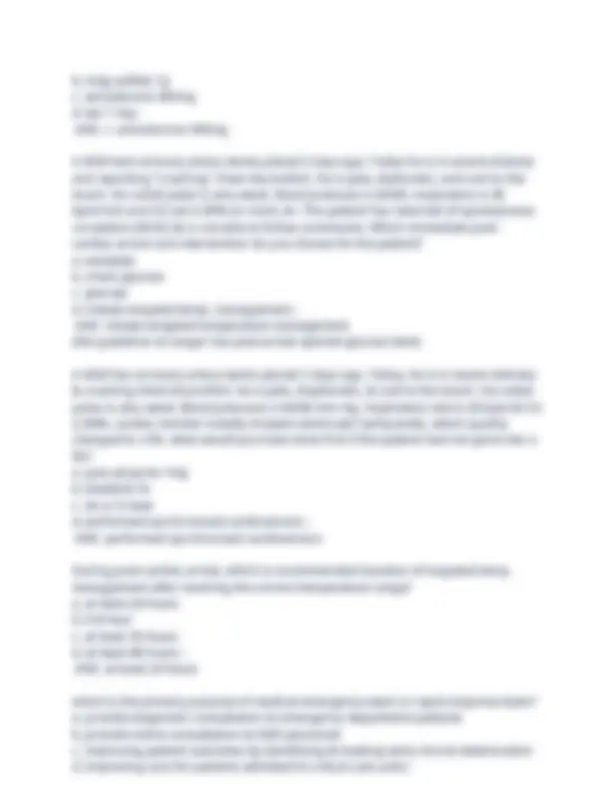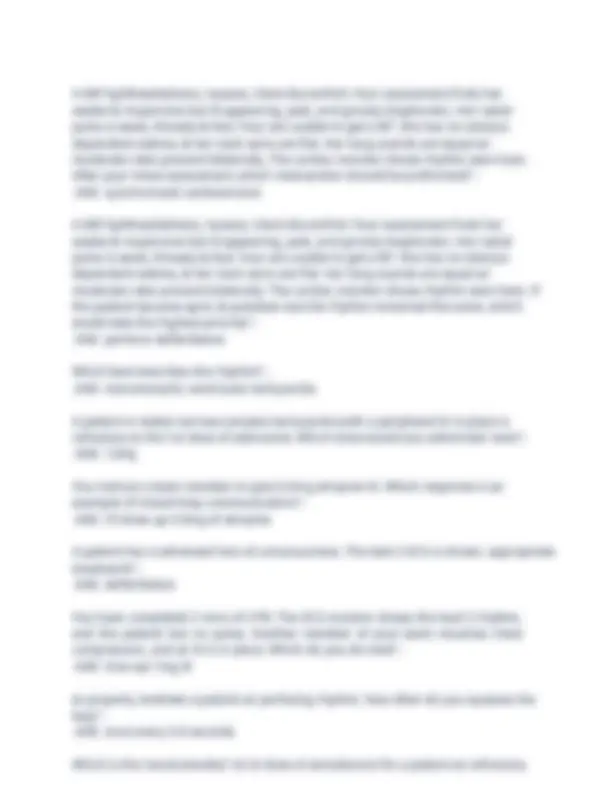








Study with the several resources on Docsity

Earn points by helping other students or get them with a premium plan


Prepare for your exams
Study with the several resources on Docsity

Earn points to download
Earn points by helping other students or get them with a premium plan
Community
Ask the community for help and clear up your study doubts
Discover the best universities in your country according to Docsity users
Free resources
Download our free guides on studying techniques, anxiety management strategies, and thesis advice from Docsity tutors
A valuable set of multiple-choice questions and answers covering key concepts in advanced cardiovascular life support (acls). it tests knowledge of various cardiac rhythms, treatment protocols, and emergency procedures. The questions are clinically relevant and ideal for medical professionals and students preparing for acls certification or seeking to enhance their understanding of emergency cardiac care. the document's focus on practical application makes it a useful tool for reinforcing learning and preparing for high-stakes scenarios.
Typology: Exams
1 / 11

This page cannot be seen from the preview
Don't miss anything!







You are caring for a patient with a suspected stroke whose symptoms started 2 hours ago. The CT was normal with no sign of hemorrhage. The patient does not have any contraindications to fibrinolytic therapy. Which treatment is best? a. start fibrinolytic therapy ASAP b. hold fibrinolytic therapy for 24 hours c. order an echo before fibrinolytic administration d. wait for MRI result - ANS a. start fibrinolytic therapy ASAP For STEMI pt, maximum goal time for ED door-to-balloon-inflation time for PCI? a. 150 mins b. 180 mins c. 120 mins d. 90 mins - ANS 90 mins Which is the recommended oral dose of ASA for a pt w/ suspected ACS? a. 81 mg b. 325-650 mg c. 160-325 mg d. 40 mg - ANS 160-325 mg chest compressions during for adult rate - ANS 100-120/min effect of excessive ventilation a. decresed cardiac output b. decreased intrathoracic pressure c. increased perfusion pressure d. increased venous return - ANS decreased cardiac output temperature to achieve targeted temperature management after cardiac arrest - ANS 32-36C 3 mins into cardiac arrest resuscitation attempt, one member of your team inserts an endotracheal tube while another performs chest compressions. Capnography
shows a persistent waveform & a PETCO2 of 8mmHg. What is the significance of the finding? a. chest compression may not be effective b. The endotrachael tube is in the esophagus
touch. His radial pulse is very weak, blood pressure is 64/40, respiratory is 28 bpm/min and O2 set is 89% on room air. despite the drug provided above & continuous CPR, the patient remains in v-fib. which drug should be given next? a. atropine 1mg
b. mag sulfate 1g c. amiodarone 300mg d. epi 1 mg - ANS c. amiodarone 300mg A 45M had coronary artery stents placed 2 days ago. Today he is in severe distress and reporting "crushing" chest discomfort. He is pale, diphoretic, and cool to the touch. His radial pulse is very weak, blood pressure is 64/40, respiratory is 28 bpm/min and O2 set is 89% on room air. The patient has returned of spontaneous circulation (ROSC) & is not able to follow commands. Which immediate post- cardiac arrest care intervention do you choose for the patient? a. extubate b. check glucose c. give epi d. initiate targeted temp. management - ANS initiate targeted temperature management (the guideline no longer has post-arrest optimal glucose level) A 45M has coronary artery stents placed 2 days ago. Today, he is in severe distress & crushing chest discomfort. he is pale, diaphoretic, & cool to the touch. His radial pulse is very weak. Blood pressure is 64/40 mm Hg, respiratory rate is 28 bpm & O is 89%. cardiac monitor initially showed ventricular tachycardia, which quickly changed to v-fib. what would you have done first if the patient had not gone into v- fib? a. give atropine 1mg b. establish IV c. do a 12 lead d. performed synchronized cardioversion - ANS performed synchronized cardioversion During post-cardiac arrest, which is recommended duration of targeted temp. management after reaching the correct temperature range? a. at least 24 hours b. 0-8 hour c. at least 36 hours d. at least 48 hours - ANS at least 24 hours which is the primary purpose of medical emergency team or rapid response team? a. provide diagnostic consultation to emergency department patients b. provide online consultation to EMS personnel c. improving patient outcomes by identifying & treating early clinical deterioration d. improving care for patients admitted to critical care units -
a. defibrillation b. perform synchronized cardioversion c. administering adenosine 6mg IV pust d. perform vagal maneuvers - ANS performing synchronized cardioversion which of these tests should be performed for a patient w/ suspected stroke w/in 25 mins of hospital arrival? a. coagulation studies b. cardiac enzymes c. noncontrast CT scan of the head d. 12 lead ECG - ANS non-contrast CT scan of the head Which of the following signs are likely indicator of cardiac arrest in an unresponsive patient? a. slow, weak pulse rate b. cyanosis c. irregular, weak pulse d. agonal gasps - ANS d. agnoal gasps a patient is being resuscitated in a very noisy environment. A team member thinks he heard an order of 500mg of amiodarone IV. which is the best response from the team member? - ANS I have an order to give 500mg of amiodarone IV. Is this correct? Which is the recommended next step after a defibrillation attempt? - ANS resume CPR, starting with chest compression A responder is caring for a patient with a history of congestive heart failure. The patient is experiencing shortness of breath, 68/50 mmHg, heart rate 190/min. The patient's lead 2 ECG is shown. Which best characterizes this patient's rhythm? - ANS unstable supraventicular tachycardia which is one way to minimize interruptions in chest compressions during CPR? - ANS continue CPR while the defibrillator charges A 68F lightheadedness, nausea, chest discomfort. Your assessment finds her awake & responsive but ill-appearing, pale, and grossly diaphoretic. Her radial pulse is weak, thready & fast. Your are unable to get a BP. She has no obvious dependent edema, & her neck veins are flat. Her lung sounds are equal w/ moderate rales present bilaterally. The cardiac monitor shows rhythm seen here.
Based on the patient's initial assessment, what adult ACLS algorithm should you follow? - ANS tachycardia wide complex (monophasic) tachycardia
ventricular fibrillation? - ANS 300mg Which best describes the length of time it should take to perform a pulse check during BLS assessment? -
ANS 5-10 seconds Which best describes an action taken by the team leader to avoid inefficiencies during a resuscitation attempt? - ANS clearly delegate tasks Which is the maximum interval you should allow for an interruption in chest compression? - ANS 10 seconds If a team member is about to make a mistake during a resuscitation attempt, which best describes the action that the team leader or other team members should take? - ANS address the team member immediately Which facility is the most appropriate EMS destination for a patient w/ a sudden cardiac arrest who achieved return of spontaneous circulation in the field? - ANS coronary reperfusion-capable medical center which is an acceptable method of selecting an appropriately sized oropharyngeal airway? - ANS measure from the corner of the mouth to the angle of the mandible A team member is unable to perform an assigned task because it is beyond the team member's scope of practice. Which action should the team member take? - ANS ask for a new task or role What is the minimum systolic blood pressure one should attempt to achieve w/ fluid administration or vasoactive agents in a hypotensive post-cardiac arrest patient who achieves return of spontaneous circulation? - ANS 90 mmHg You are evaluating a 58M w/ chest discomfort, BP 92/50, heart rate 92/min, his non- labored respiratory rate is 14 bpm, and his pulse oximetry reading is 97%. Which assessment step is most important now? - ANS obtaining a 12 lead As a team leader, when do you tell the chest compressors to switch? - ANS about every 2 minutes The patient's pulse ox shows a reading of 84% on room air. Which initial action do you take? - ANS apply oxygen (I think I put Bag valve mask for this and I got it wrong)